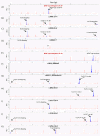Comprehensive splicing functional analysis of DNA variants of the BRCA2 gene by hybrid minigenes
- PMID: 22632462
- PMCID: PMC3446350
- DOI: 10.1186/bcr3202
Comprehensive splicing functional analysis of DNA variants of the BRCA2 gene by hybrid minigenes
Abstract
Introduction: The underlying pathogenic mechanism of a large fraction of DNA variants of disease-causing genes is the disruption of the splicing process. We aimed to investigate the effect on splicing of the BRCA2 variants c.8488-1G > A (exon 20) and c.9026_9030del (exon 23), as well as 41 BRCA2 variants reported in the Breast Cancer Information Core (BIC) mutation database.
Methods: DNA variants were analyzed with the splicing prediction programs NNSPLICE and Human Splicing Finder. Functional analyses of candidate variants were performed by lymphocyte RT-PCR and/or hybrid minigene assays. Forty-one BIC variants of exons 19, 20, 23 and 24 were bioinformatically selected and generated by PCR-mutagenesis of the wild type minigenes.
Results: Lymphocyte RT-PCR of c.8488-1G > A showed intron 19 retention and a 12-nucleotide deletion in exon 20, whereas c.9026_9030del did not show any splicing anomaly. Minigene analysis of c.8488-1G > A displayed the aforementioned aberrant isoforms but also exon 20 skipping. We further evaluated the splicing outcomes of 41 variants of four BRCA2 exons by minigene analysis. Eighteen variants presented splicing aberrations. Most variants (78.9%) disrupted the natural splice sites, whereas four altered putative enhancers/silencers and had a weak effect. Fluorescent RT-PCR of minigenes accurately detected 14 RNA isoforms generated by cryptic site usage, exon skipping and intron retention events. Fourteen variants showed total splicing disruptions and were predicted to truncate or eliminate essential domains of BRCA2.
Conclusions: A relevant proportion of BRCA2 variants are correlated with splicing disruptions, indicating that RNA analysis is a valuable tool to assess the pathogenicity of a particular DNA change. The minigene system is a straightforward and robust approach to detect variants with an impact on splicing and contributes to a better knowledge of this gene expression step.
Figures



References
-
- Ford D, Easton DF, Stratton M, Narod S, Goldgar D, Devilee P, Bishop DT, Weber B, Lenoir G, Chang-Claude J, Sobol H, Teare MD, Struewing J, Arason A, Scherneck S, Peto J, Rebbeck TR, Tonin P, Neuhausen S, Barkardottir R, Eyfjord J, Lynch H, Ponder BA, Gayther SA, Zelada-Hedman M. the Breast Cancer Linkage Consortium. Genetic heterogeneity and penetrance analysis of the BRCA1 and BRCA2 genes in breast cancer families. The Breast Cancer Linkage Consortium. Am J Hum Genet. 1998;62:676–689. doi: 10.1086/301749. - DOI - PMC - PubMed
-
- The Breast Cancer Information Core Database. http://research.nhgri.nih.gov/projects/bic (Accessed June 2011)
-
- Vallon-Christersson J, Cayanan C, Haraldsson K, Loman N, Bergthorsson JT, Brondum-Nielsen K, Gerdes AM, Moller P, Kristoffersson U, Olsson H, Borg A, Monteiro AN. Functional analysis of BRCA1 C-terminal missense mutations identified in breast and ovarian cancer families. Hum Mol Genet. 2001;10:353–360. doi: 10.1093/hmg/10.4.353. - DOI - PMC - PubMed
-
- Farrugia DJ, Agarwal MK, Pankratz VS, Deffenbaugh AM, Pruss D, Frye C, Wadum L, Johnson K, Mentlick J, Tavtigian SV, Goldgar DE, Couch FJ. Functional assays for classification of BRCA2 variants of uncertain significance. Cancer Res. 2008;68:3523–3531. doi: 10.1158/0008-5472.CAN-07-1587. - DOI - PMC - PubMed
Publication types
MeSH terms
Substances
LinkOut - more resources
Full Text Sources
Other Literature Sources
Medical
Miscellaneous

